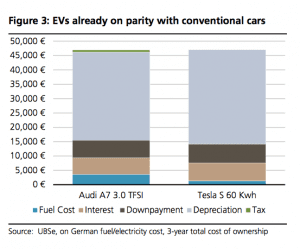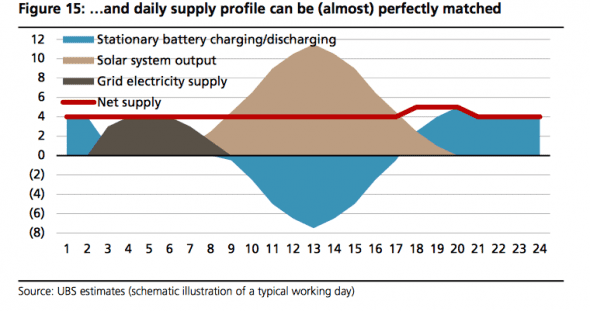How EVs Could Make Solar Viable Without Subsidies
Investment bank UBS says the addition of electric vehicles, and the proliferation of battery storage, will solve the problem of intermittency for rooftop solar and make it viable without subsidies. So much so, it says, that households will be able to budget for 12 years of “free electricity” for a 20-year solar system.
In a major report on the “revolution” that could hit energy markets any time soon, UBS says – as we report here – that the combination of EVs plus solar plus storage will deliver a payback time of 6-8 years by 2020 – effectively making centralised fossil fuel generation redundant.
It says this is not understood by the utility industry or the market, because they are “not yet looking at the topics of solar, EVs and stationary batteries with a holistic view.”
“Our proprietary model (above) shows it is the combination of the three that makes solar fully competitive and that has the potential to bring disruptive changes to the electricity sector.
“Here are the maths: One can leverage the EV purchase with an investment in a solar system and a stationary battery. By doing so, one can optimise the self-consumption of solar power and minimise the “excess waste” of solar electricity.
“And what also may matter to many EV buyers: The electricity used to drive the car is carbon-free. The combination of and EV + solar + battery should have a payback of 7-11 years, depending on the country-specific economics. In other words, based on a 20-year technical life of a solar system, a German buyer should receive 12 years of electricity for free (purchase in 2020).”
 Chip in a few dollars a month to help support independent cleantech coverage that helps to accelerate the cleantech revolution!
Chip in a few dollars a month to help support independent cleantech coverage that helps to accelerate the cleantech revolution!
UBS says pure battery EVs will be competitive with cars with internal combustion engines, and in some instance may already be so.
 As this table to the right shows, the 3-year total cost of ownership (TCO) of a Tesla S model is similar to that of a comparable petrol combustion engine car such as an Audi A7, especially in markets with high fuel prices like Germany – a country where purchase incentives are almost non- existent.
As this table to the right shows, the 3-year total cost of ownership (TCO) of a Tesla S model is similar to that of a comparable petrol combustion engine car such as an Audi A7, especially in markets with high fuel prices like Germany – a country where purchase incentives are almost non- existent.
“We think that by 2020, shrinking battery and solar cost will make EVs in the mass segments the cheaper alternative over a car life cycle in most European markets.
“While on a global basis, EV sales for the remainder of the decade should be mostly carbon/fuel standards and related incentives, we think penetration rates will accelerate significantly after 2020 driven by compelling economics. As a conservative 2025 scenario, we think about 10% of new car registrations in Europe will be EVs.”
So, how does this work in practice?
UBS provides the table below to explain why solar plus stationary battery plus electric vehicle, in combination with smart demand, is an almost perfect fit.
EV charging during the night smoothes the daily demand curve. The stationary battery stores excess solar electricity during the day and releases it in the evening hours.
The remaining supply gap will be filled with electricity from the grid during the night/early morning hours, which is when spot prices are low and there is excess base-load and wind power supply. On top (not illustrated below), the stationary battery may be re-charged in the early morning hours with excess grid electricity (at low prices) and supply the morning demand peak during breakfast hours.
Source: RenewEconomy. Reproduced with permission.
Have a tip for CleanTechnica? Want to advertise? Want to suggest a guest for our CleanTech Talk podcast? Contact us here.
Latest CleanTechnica.TV Video

CleanTechnica uses affiliate links. See our policy here.


